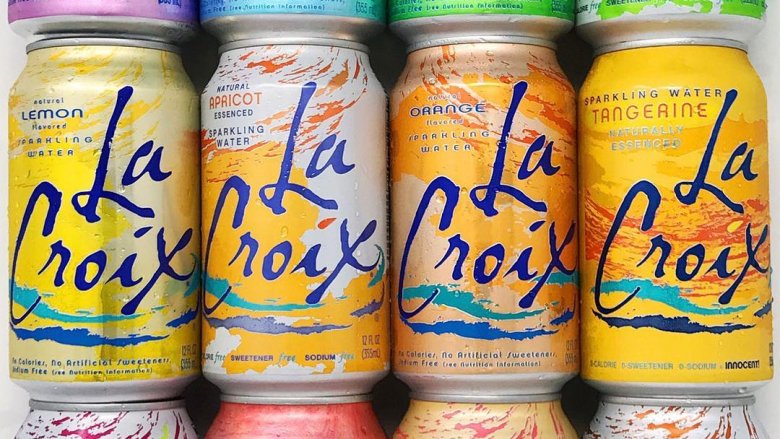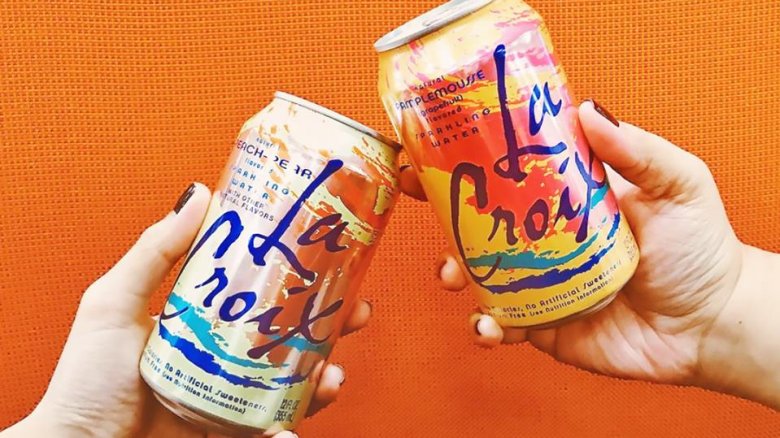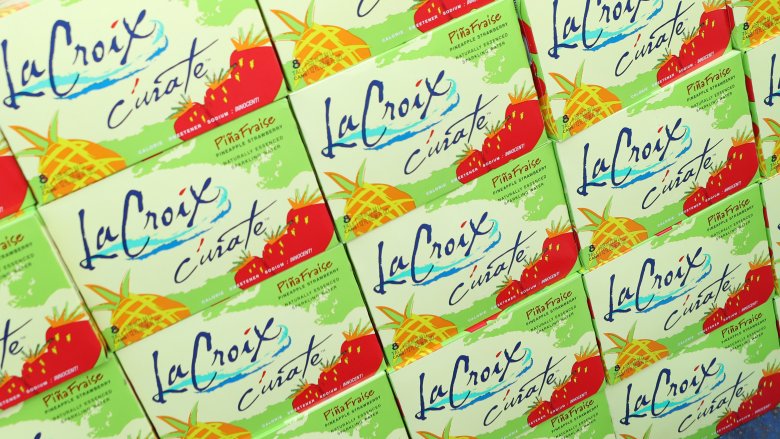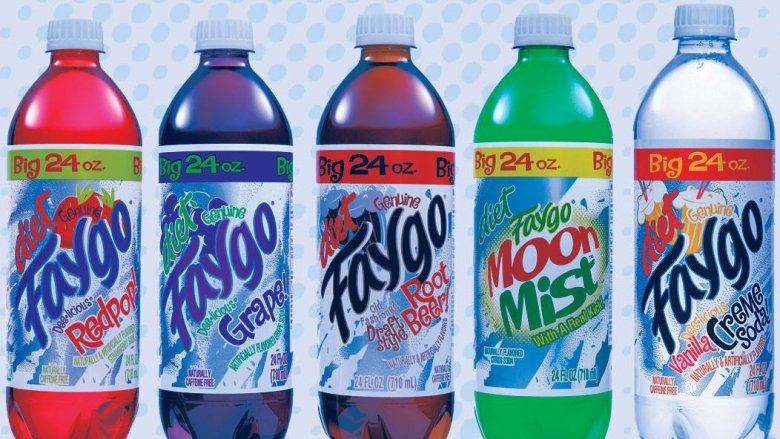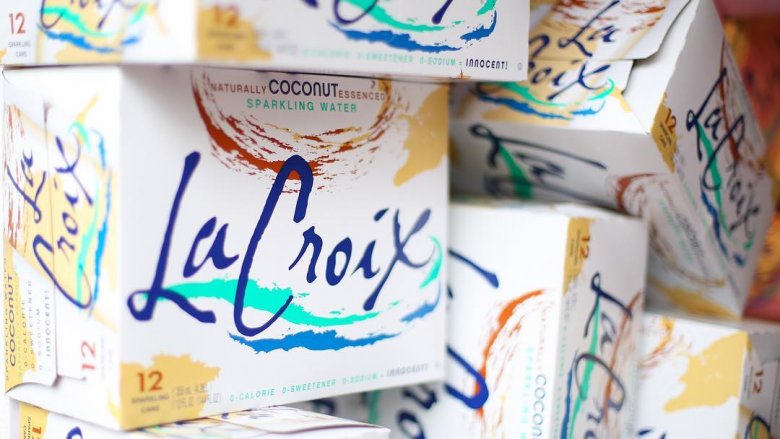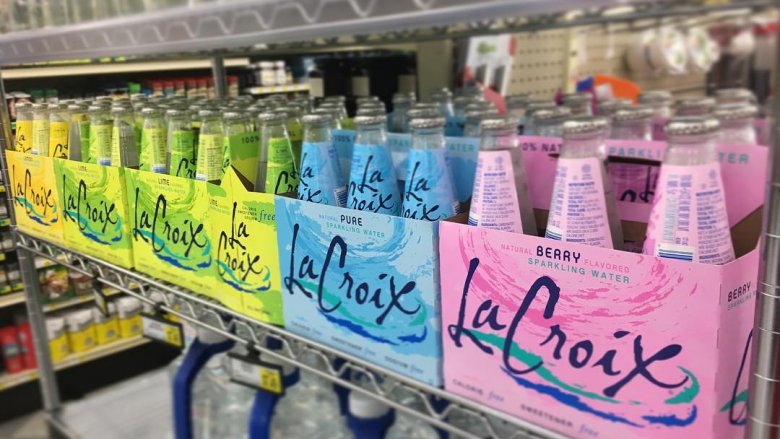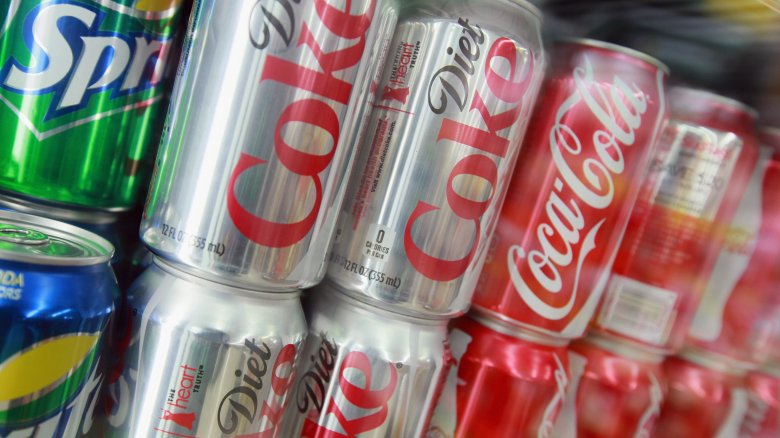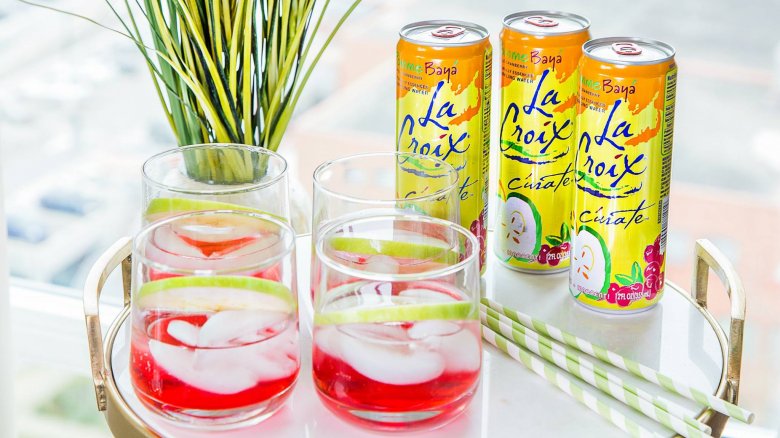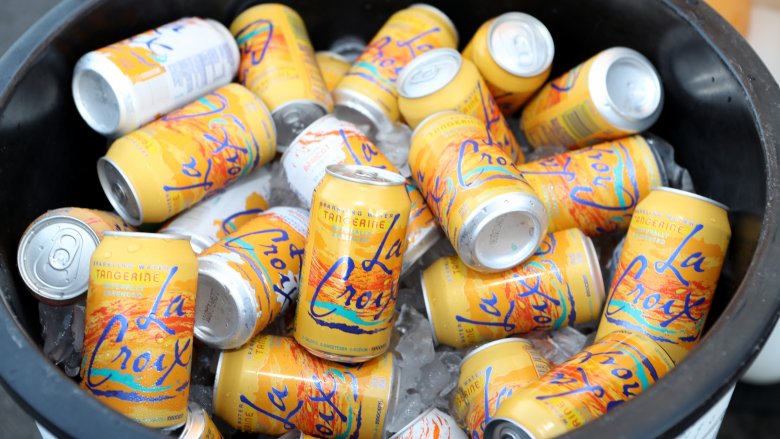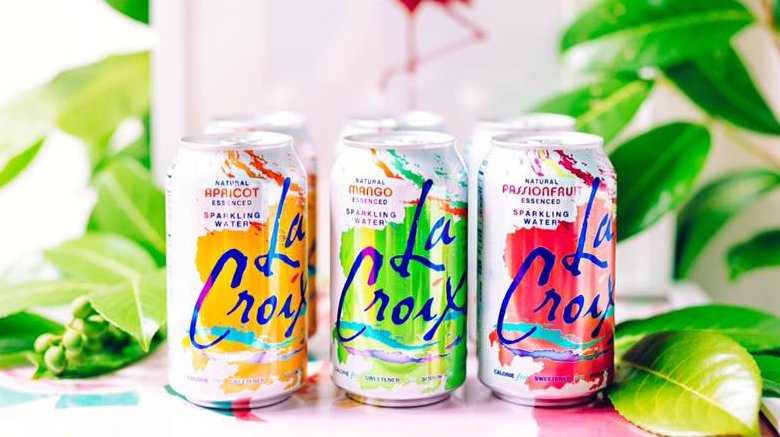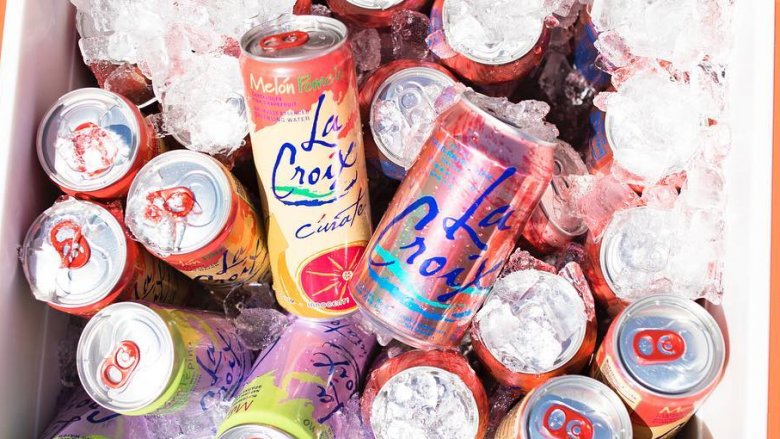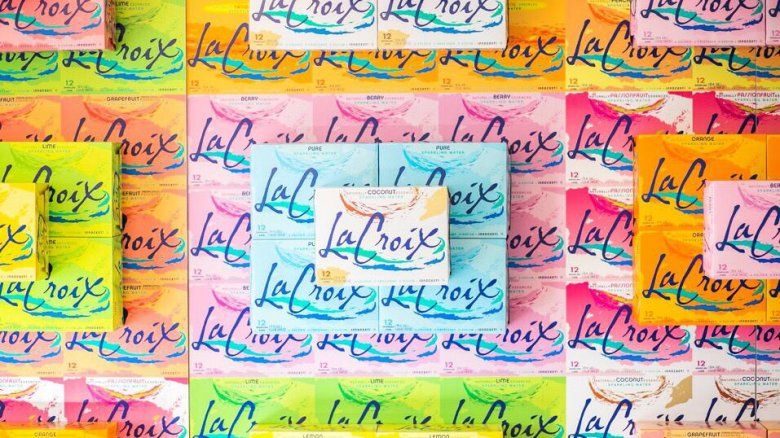The Untold Truth Of LaCroix
I'll get this out of the way first in the interest of full disclosure: I love LaCroix sparkling water. I mean I really, really love it. I'm drinking it right now. And I haul 24-packs of it from Costco up to my eighth floor apartment (without an elevator, mind you) because I need that much around.
But I am far from alone in my obsession with LaCroix, a fruit-infused, calorie- and sweetener-free, carbonated beverage that has garnered a cult following as more and more people are ditching sugary or artificially-sweetened drinks. How did this cult following come to be, beating out beverage juggernauts Perrier, Coca-Cola, and Nestlé? What makes it so special, and is it too good to be true? It almost seems as if it just popped up on the store shelves one day, out of the blue... but that's far from what really happened. Here's the story of the beverage that people can't get enough of.
It's not French
It's not la-croiks or la-kwah, nor is it la crow-ix. It's pronounced la-croy, just like the island in the Caribbean, St. Croix. And if you forget, just remember that LaCroix rhymes with enjoy, which is what you will do when you drink it.
Another misconception about LaCroix not unrelated to its name is its origin story. It was not conceived of in a boardroom in Paris with Perrier executives spying from next door. Nor was it born in Ft. Lauderdale, where the parent company, National Beverage Corp., is headquartered. Rather, LaCroix traces its humble origins to La Crosse, Wisconsin, where it was originally made in a family owned brewery, G. Heileman, starting in 1981. The "La" in the name was taken from La Crosse, and the "Croix" comes from the St. Croix River, a tributary of the Mississippi River.
National Beverage Corp. purchased LaCroix in 1996, so like many snowbirds, LaCroix left the frozen north for sunny Florida where it's here to stay.
It's not all good for you
Certainly the lack of calories, additives, and caffeine are what make LaCroix so popular with a lot of health-conscious folks. But despite multiple people praising it for its healthfulness, LaCroix is not 100 percent good for you. For example, one big problem is the fact that carbonated beverages can have a negative impact on your tooth enamel, rendering your teeth sensitive and, in some cases, weakened. Additionally, if you're invested in not gaining weight, that could present a problem — rats who indulged in sparkling water had an increase in the appetite-increasing hormone ghrelin, and ended up gaining weight. So if you can moderate your intake it's not a bad idea, as you can reduce the risk of any potential negative impacts. It's worth noting though, that although it's not a perfect choice, it's still a much better choice than sugary soda!
It has an unlikely sibling
On the surface, Faygo seems like it could be the antithesis of LaCroix. It's full of sugar — up to 50 grams per can — and is packed with artificial colors and flavors. How else do you explain blue, cotton candy flavored pop? Additionally, it's the beverage of choice for juggalos everywhere, superfans of the band Insane Clown Posse, who bathe in streams of the stuff at concerts. One wonders about how large the fiscal impact is for the brand given that the rap-rock duo go through 350 two-liter bottles in one show alone.
But Faygo and LaCroix are closer than you think, not just because they both have super colorful labels and fonts that scream 1987. They're both owned and distributed by National Beverage Corp., which makes them siblings of a sort. I doubt ICP will be spraying LaCroix on their audiences anytime soon, though.
That flashy label hasn't always been around
National Beverage Corp. has some slick marketing genius, as is evident by their success and widespread popularity. A major part of it is because of the quirky, colorful label that graces the LaCroix products. But those flashy, Florida styled images were not the original package design — rather, National Beverage Corp. sought a re-branding back in 2002 in an attempt to breath new life into their new acquisition. They hired Alchemy Brand Group, a branding company, to create a look that would help them stand apart from all of the other fizzy drinks at your local grocery store. But instead of keeping the final decision in-house, National Beverage Corp. agreed to let the consumers decide, selecting three out of 20 images to undergo a vote. And vote they did — the current design won by a landslide, beating out the more restrained designs of the time.
And while it was certainly an outlier, with its flashy colors and swirling colors, trusting the consumers paid off, big time.
You don't have to buy it in cans
If you follow La Croix on Instagram, you'll be greeted by the smiling faces of attractive millennials sipping on cans of LaCroix in all kinds of beautiful, tropical locations. You'll also come across cute babies, impressive store displays, and the occasional cat or dog.
What you won't find much of on Instagram, however, are bottles of LaCroix, which is odd because they certainly do sell them. It's possible that cans hold in the carbonation better than plastic, which would explain the preference for cans, but temperature and storage matter much more than packaging when it comes to preservation. Or, perhaps it's just another instance of mysterious, slick marketing.
It's more popular than soda
Few things are more American than soda — it's fizzy, it's sugary, and it's everywhere on the planet. And although there are still plenty of soda drinkers out there, thanks to its sweet taste and carbonated goodness (plus years of slick and assertive marketing), you can put it on the long list of things that millennials are killing along with Applebee's and cigarettes. That's because millennials are a decidedly healthier generation, and are more likely to eat well, exercise, and intentionally cultivate wellness habits. Bearing this in mind, it's no surprise that millennials are less interested in soda than their predecessors.
What better drink to fill the fizzy void than LaCroix? A major part of the appeal is the fact that it's free of calories, sodium, and unnatural flavors — a millennial drink of choice, now with bubbles. The rest is due to the savvy marketing of National Beverage Corp., who beat out competitors like Perrier with the ability to appeal to hipsters everywhere.
It makes a great cocktail
LaCroix is often touted as being a hydrating, calorie-free beverage with a unique, fruity essence. If anything ever sounded like the perfect cocktail mixer, that would be it, especially with the intense carbonation. Well, the folks at National Beverage Corp. seem to agree, as they've published a list of cocktail recipes on their website. There's a whole list of mocktails, from blackberry lemon fizz to the Miami mama mocktail. And while these recipes don't include alcohol, you can certainly tweak them to include wine or spirits. Additionally, there are lots of recipes out there that use LaCroix in alcoholic cocktails, but they're not affiliated with the company itself.
You can design your own can
If you're especially obsessed with LaCroix and have a proclivity for design, this website is for you. Yes, someone was kind enough to create a site that allows you to create and customize your own virtual can of LaCroix with an array of colors. You can also label it with the flavor of your choice, be it a flavor blend you'd like to see (chocolate and rose water, please!) or something more branded like your last name. Sadly, there's no way to turn it into an actual can of LaCroix, but you can certainly burn some time tweaking colors until your aesthetic is satisfied.
It can help you kick your pop habit
Looking to kick your Mountain Dew habit? LaCroix could very likely assist you in that pursuit, helping you to live a healthier, slimmer, and more hydrated life. I, like many people, got hooked on LaCroix in an effort to stop drinking too much soda. After a couple of days, I didn't even miss it — LaCroix filled the void, with its carbonation and fruit-infused flavor. Now that I'm a longtime LaCroix drinker, I don't really like soda at all, though I will have the occasional Diet Coke with a meal at a restaurant.
There are so many choices
One of the things that those of us in the cult of LaCroix love is the diversity of flavors. You can select from more than 20 flavors, such as orange, coconut, passionfruit, and pamplemousse (French for grapefruit), and so on. This includes regular LaCroix, as well as LaCroix Cúrate, which is their first brand extension. Products in the Cúrate line have a stronger flavor profile, and are canned in a tall, slim, 12-ounce can. Flavors include muré pepino (blackberry and cucumber), piña fraise (pineapple strawberry), and melón pomelo (cantaloupe and grapefruit).
One of the newest flavors, also its own product line, is fascinating when taken into context with the beverage industry. It's called LaCroix Nicola, and it's basically sparkling water infused with the essence of cola. But unlike all of the other colas on the market, it has no sugar or sweetener — just the cola essence. Wouldn't it be crazy if cola-flavored seltzer takes over the market? Where would that leave the original cola makers? Only time will tell.
It made the founder a billionaire
Who knew flavored fizzy water could make you part of the one percent? Apparently Nick Caporella, CEO and majority shareholder of National Beverage Corp., had an inkling, and he was right. A coal miner's son, Caporella started out in construction after purchasing a dragline excavator in 1957. After building that business, he moved onward and upward, becoming CEO of Burnup & Sims, a telecommunication and cable company, in 1976. Shortly thereafter, he acquired his first bottling plants (among other enterprises), and continued to grow the business.
Under threat of a hostile takeover, however, he set up a new company — National Beverage Corp. — in 1985, and additionally purchased Shasta, a soft drink company. Then in 1996 he purchased LaCroix, as the country started thirsting for healthier drinks. And the trend only increased, sending National Beverage shares through the roof and making it the fourth-largest soft drink company in the world. And since Caporella is the majority shareholder of the company, that makes him a billionaire.
It has a song — and it's catchy
Relax, sit back, and sip your LaCroix while watching this fan homage. Like LaCroix, it will definitely bring you joy.
